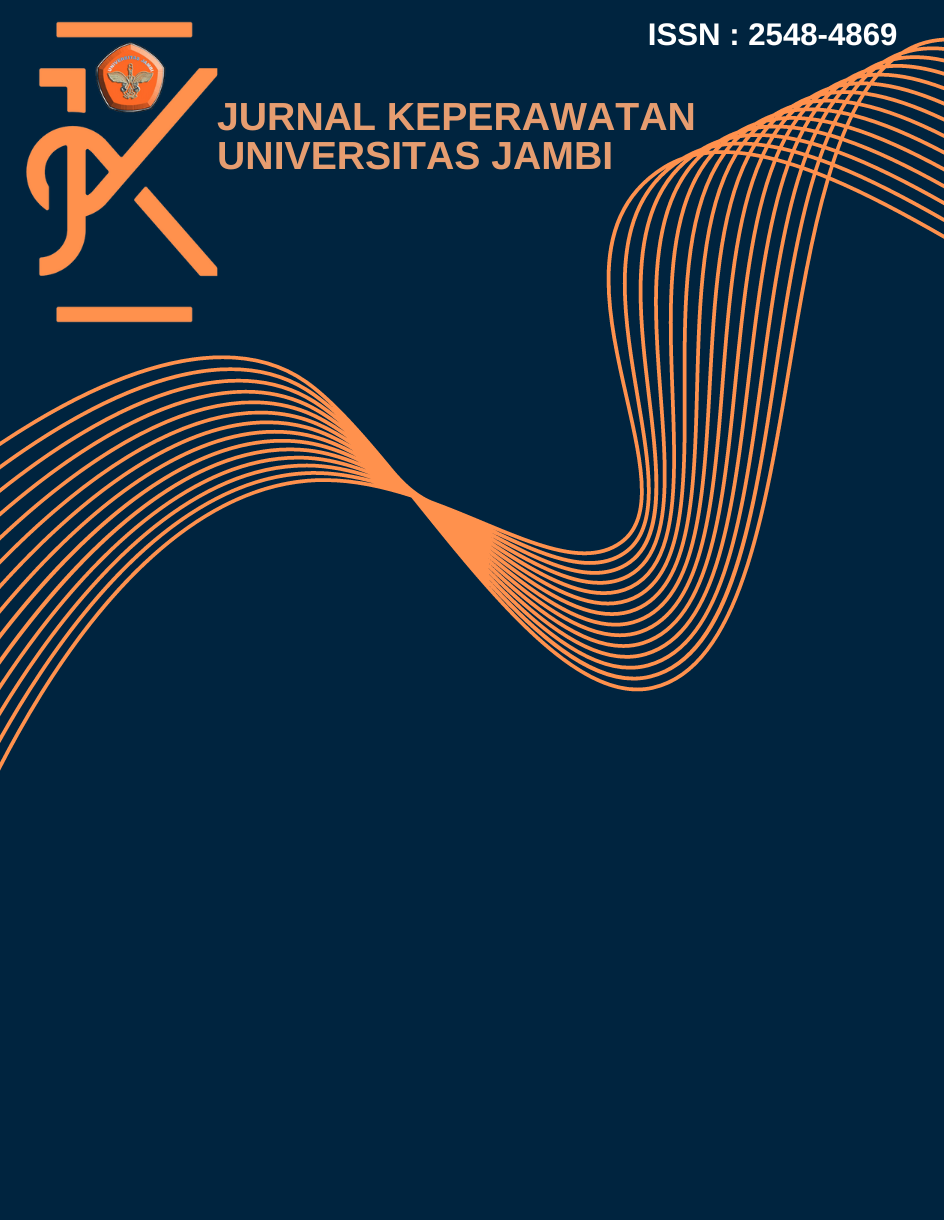Overview Of Nurses' Knowledge About Progressive Mobilization In The Intensive Care Unit (ICU), Surgery, Internal Disease Prof. Dr. H.M Chatib Quzwain Sarolangun
DOI:
https://doi.org/10.22437/jkuj.v8i3.19861Abstract
Bed rest is a risk factor for infection, contractures, pressure ulcers, and blood clots. Stating that after 2 weeks of bed rest, there can be a loss of muscle mass of 5%-9%and a decrease in muscle strength of up to 20%-27% To describe the knowledge of nurses about progressive mobilization in the intensive care unit (ICU), surgery, internal medicine, Prof. Dr. H. M. Chatib Quzwain Sarolangun. This study uses a quantitative descriptive study plan, namely a research design in which measurements or observations are carried out simultaneously at one time to find out the Description of Nurses' Knowledge About Progressive Mobilization in the Intensive Care Unit (ICU), Surgery, Internal Medicine, Prof. . Dr. H.M Chatib Quzwain Sarolangun. The distribution of the age frequency of the 51 respondents with the highest knowledge was 32 respondents (62.7%). So it can be concluded that the respondents in this study had more high knowledge than those with low knowledge It is known that from51respondents the most are high knowledge as many as 32 respondents (62.7%). So it can be concluded that the respondents in this study had more high knowledge than those with low knowledge. The results of this study are expected to be used as input, theory and reference material, especially for nurses about progressive mobilization in critically ill patients in the ICU, Surgery and Internal Medicine.
Downloads
References
1. Aboshoushah, E. et al. (2023) ‘The Role of Early Mobilization and Physiotherapy Interventions in the Recovery of Critically Ill Patients in the Intensive Care Unit’, Journal of Healthcare Sciences, 03(06), pp. 181–188. doi: 10.52533/johs.2023.30603.
2. Alimul, Hidayat A.A. (2008). Metode Penelitian Kebidanan dan Teknik Analisa Data. Jakarta: Salemba Medika.
3. Berman, Audrey, Synder, Shirlee, Kozier, Barbara, G. (2009). Buku Ajar Praktik Keperawatan Klinis (5th ed.). Jakarta: EGC.
4. Chang, Esther; Daly, John; dan Elliot, Doug. (2010). Patofisiologi Aplikasi Pada Praktik Keperawatan. Jakarta: Penerbit Buku Kedokteran EGC.
5. Chen, B. et al. (2021) ‘A systematic review and meta-analysis of the effects of early mobilization therapy in patients after cardiac surgery’, Medicine (United States), 100(15), p. E25314. doi: 10.1097/MD.0000000000025314.
6. Clini, E., & Ambrosino, Nicolino. (2005). Early physiotherapy in the respiratory intensive care unit, 1096–1104. doi: 10.1016/j.rmed.2005.02.024.
7. Depkes RI. (2010). Capaian Pembangunan Kesehatan Tahun 2011. Jakarta.
8. Dubb, R. et al. (2016) ‘Barriers and strategies for early mobilization of patients in intensive care units’, Annals of the American Thoracic Society, 13(5), pp. 724–730. doi: 10.1513/AnnalsATS.201509-586CME.
9. Erniody. (2012). Pemantauan Hemodinamik Invasif, Semiinvasif atau Non Invasif? Jakarta: Rumah Sakit Husada.
10. Formenti, P. et al. (2025) ‘Combined Effects of Early Mobilization and Nutrition on ICU-Acquired Weakness’, Nutrients, 17(6), pp. 1–16. doi: 10.3390/nu17061073.
11. Hudak, C. M., & Gallo. (1997). Keperawatan Kritis: Pendekatan Holistik (pp. 82–83). Jakarta: EGC Penerbit Buku Kedokteran.
12. Jevon, P., & Ewens, B. (2019). Pemantauan Pasien Kritis (V. Umami, Ed.) (2nd ed.). Jakarta: Erlangga Medical Series.
13. Juita, J., Yona, S., and Maria, R. (2023) ‘The Benefits of Early Mobilization on Post-Abdominal Surgery: A Review of Literature’, Jurnal Ilmiah Ilmu Keperawatan Indonesia, 13(01), pp. 21–33. doi: 10.33221/jiiki.v13i01.2377.
14. Katili, Muhlis. (2014). Bagaimana Memahami Konsep Dasar Hemodinamik Secara Sederhana. Diakses tanggal 12 Agustus 2017.
15. KEMENKES RI. (2011). Pedoman Pelaksanaan Jaminan Kesehatan Masyarakat. Jakarta: Kemenkes.
16. Kozier. (2019). Buku Ajar Praktik Keperawatan Klinis. 5th ed. Fruriolina A, editor. Jakarta: EGC.
17. Mattone, J. (2019). Implementing an Early Progressive Mobility Protocol in the Intensive Care Unit.
18. Notoatmodjo. (2012). Metode Penelitian Kesehatan. Jakarta: Rineka Cipta.
19. Nurhadi. (2014). Gambaran dukungan perawat pada keluarga pasien kritis di rumah sakit umum pusat Dr. Kariadi. Program studi S1 Ilmu Keperawatan, Universitas Diponegoro.
20. Pande, S., Kolekar, B.D., & Vidyapeeth, D.Y.P. (2013). Training programs of nurses working in intensive care unit. International Journal of Advanced Research in Management and Social Sciences, 2(suppl.6), 85–87.
21. Potter, Perry. (2011). Fundamental Of Nursing: Concept, Process and Practice. Edisi 7. Vol. 3. Jakarta: EGC.
22. Rauen, C.A., Makic, M.B.F., & Bridges, E. (2009). Evidence-based practice habits: transforming research into bedside practice. Critical Care Nurse, 29(2), 46–59; quiz 60–61. doi: 10.4037/ccn2009287.
23. Sandi, N. I. (2016). Pengaruh Latihan Fisik Terhadap Frekuensi Denyut Nadi. Journal Sport and Fitness, 4(2).
24. Saputra, B. R., & Indrawanto, I. S. (2013). Profil penderita hipertensi di RSUD Jombang periode, 116–120.
25. Schaller, S. J. et al. (2024) ‘Guideline on positioning and early mobilisation in the critically ill by an expert panel’, Intensive Care Medicine, 50(8), pp. 1211–1227. doi: 10.1007/s00134-024-07532-2.
26. Silva, G. Eduardo. (2018). Political Science. New Orleans: Tulane University.
27. Singam, A. (2024) ‘Mobilizing Progress: A Comprehensive Review of the Efficacy of Early Mobilization Therapy in the Intensive Care Unit’, Cureus, 16(4). doi: 10.7759/cureus.57595.
28. Stillwell, S. B. (2011). Pedoman Keperawatan Kritis (P. Eko Karyuni, Ed.) (3rd ed.). Jakarta: EGC.
29. Stiller, Kathy. (2007). Safety issues that should be considered when mobilizing critically ill patients. Critical Care Clinics, 23(1), 35–53. doi: 10.1016/j.ccc.2006.11.005.
30. Sugiyono. (2015). Metode Penelitian Kombinasi (Mix Methods). Bandung: Alfabeta.
31. Tazreean, R., Nelson, G., & Twomey, R. (2022) ‘Early mobilization in enhanced recovery after surgery pathways: Current evidence and recent advancements’, Journal of Comparative Effectiveness Research, 11(2), pp. 121–129. doi: 10.2217/cer-2021-0258.
32. Vollman, K. M. (2010). Introduction to progressive mobility. Critical Care Nurse, 30(2), S3–S5. doi: 10.4037/ccn2010803.
33. Zhang, H. et al. (2022). ‘Early mobilization implementation for critical ill patients: A cross-sectional multi-center survey about knowledge, attitudes, and perceptions of critical care nurses’, International Journal of Nursing Sciences, 9(1), pp. 49–55. doi: 10.1016/j.ijnss.2021.10.001.
34. Zhou, J. et al. (2022). ‘Effect of early progressive mobilization on intensive care unit-acquired weakness in mechanically ventilated patients: An observational study’, Medicine (United States), 101(44), p. E31528. doi: 10.1097/MD.0000000000031528.
Downloads
Published
How to Cite
Issue
Section
License
Copyright (c) 2024 Nurlaili Andraini, Yosi Oktarina, Andi Subandi

This work is licensed under a Creative Commons Attribution 4.0 International License.






